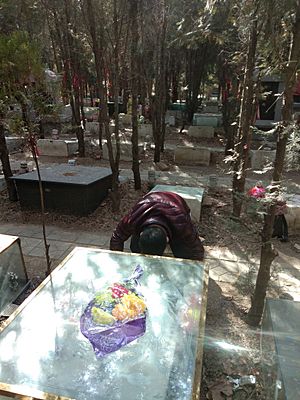Kowtow facts for kids
Quick facts for kids Kowtow |
|
|---|---|
|
.
|
The kowtow is a way of showing deep respect by kneeling and bowing so low that your head touches the ground. The word "kowtow" comes from the Cantonese language. This custom started a very long time ago in China, possibly between the Spring and Autumn period or the Warring States period. It was definitely a common practice by the time of the Qin dynasty (221 BC – 206 BC).
In East Asian cultures, the kowtow was the highest sign of respect. People used it to show honor to their elders, people in charge, and especially the Emperor. It was also used for religious ceremonies and to show respect for important cultural objects. Today, the kowtow is not used as much as it used to be.
Traditional Ways of Showing Respect
In ancient China, people would perform the kowtow in front of the Emperor. There were different levels of kowtow depending on how important the situation was. For the most important events, like when a new Emperor was crowned, people would do the "three kneelings and nine kowtows." This meant they would kneel down three times from a standing position. Each time they knelt, they would bow their head to the ground three times. This was known as the grand kowtow.
Government officials also represented the Emperor's power. So, ordinary people had to kowtow to them in formal situations. For example, if a common person was brought before a local judge, they had to kneel and kowtow. They then had to stay kneeling. However, someone who had passed the special Imperial examinations was allowed to sit down.
According to Confucian ideas, it's very important to show great respect to your parents and grandparents. Because of this, children might also kowtow to their older family members, especially on special days. For instance, at a wedding, the couple getting married traditionally kowtowed to both sets of parents. This showed thanks for all the care and nurturing they had received.
Confucius believed that the body and mind were connected. He thought that actions done with the body would affect the mind. When you place your body in a low position during a kowtow, the idea is that you will naturally feel respect in your mind. What you do physically influences your thoughts and feelings. Confucian ideas taught that respect was very important for a good society. This made bowing and kowtowing important rituals.
Modern Chinese Usage
After the May Fourth Movement in the early 1900s, the kowtow and other old ways of showing respect became less common. Today, only a few traces of the traditional kowtow remain. In many situations, people now use a standing bow instead of the kowtow. For example, some people might choose to kowtow at an ancestor's grave or when making traditional offerings. Others might just bow.
At a funeral for an ancestor, direct family members might kowtow, while others simply bow. During a wedding, some couples still kowtow to their parents, but a standing bow is more common now. In very serious situations, the kowtow can be used to show deep thanks, to say sorry, or to ask for forgiveness.
The kowtow is still used in some traditional training ceremonies. This includes when someone becomes an apprentice or a student. For example, in Chinese martial arts schools, students often kowtow to their master. Similarly, traditional performing arts often require the kowtow as part of their training.
Images for kids
See also
 In Spanish: Kowtow para niños
In Spanish: Kowtow para niños





